Satisfyingly crunchy fermented refrigerator pickles with lots of flavor that are SUPER easy to make! Full of healthy probiotics, these pickles are frankly a little addicting. I started out making two jars with some cucumbers that a friend gifted me from her garden, then when those pickles ran out WAY too quickly, I wanted more pickles but I had no cucumbers, so I made another jar of my lovely fermented pickles using zucchini and carrots with some added peppers in place of the cucumbers.
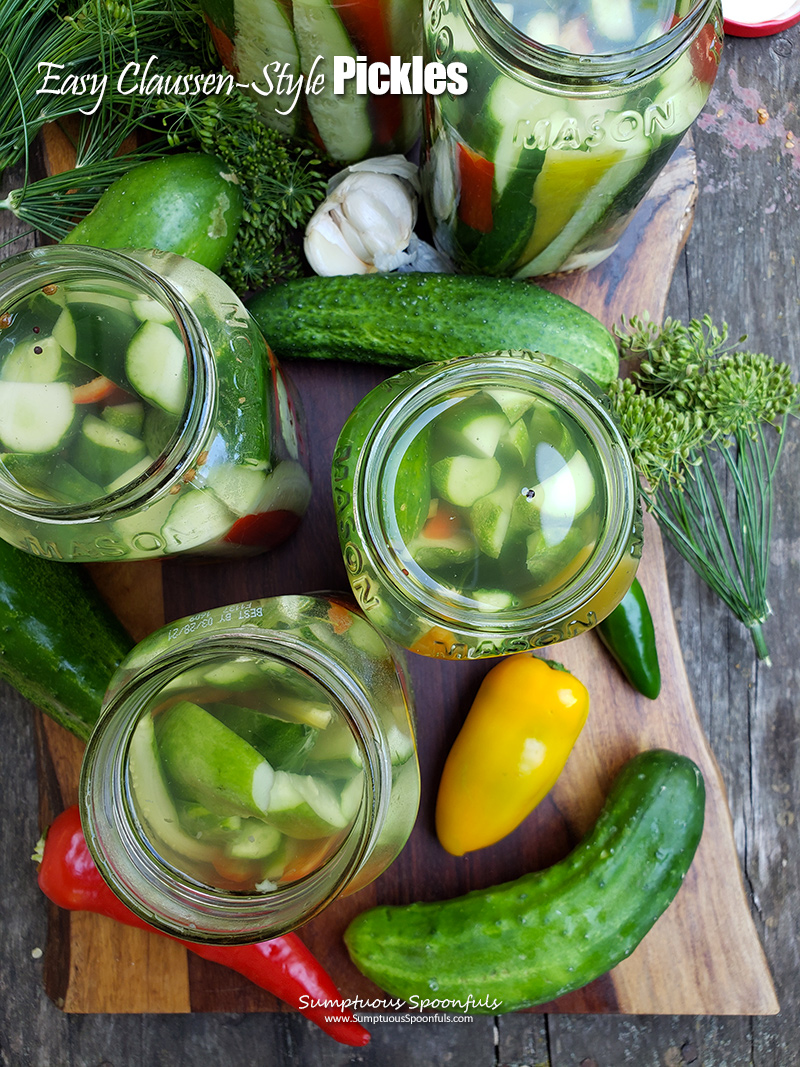
Then I visited my parents who had LOADS of cucumbers, helped them make a gargantuan amount of fermented pickles and took the rest home to relieve them of the burden (and also feed my latest eating addiction). I need a little something to munch on before bedtime when I’m craving a little something and I’ve decided it’s better to eat a couple pickles to satisfy me than some more calorie-laden that riddles me with guilt when I step on the scale in the morning. These home-fermented pickles taste amazing and they make me FEEL so good too! Also, the probiotics help boost my immune system at a time when the COVID Delta variant is on the rise. (Yes, I’m fully vaccinated, so I feel pretty good about my immunity, but still this new variant is even getting vaccinated people sick, and I worry about passing on the virus to others who are not protected or who have health issues, so anything I can do to boost my immune system is welcome.)
Bonding via Food … Precious Time with Family
For almost as long as I can remember, our family time has centered around food. My mom and dad always had a big, vibrant vegetable garden and we always, always cooked together. My parents both came from farms, so raising food is second nature to them. I gained my appreciation of nature, gardening, cooking and sharing food from them. Food is one of our most basic needs, so sharing food and/or drink creates a deep connection between us.
Some of my earliest childhood memories center around food: making donuts on Sundays with Dad, harvesting corn, making dinner. My parents involved us in the gathering, preparing and preserving of food. We helped pick, clean, package and preserve so many things: venison, corn, green beans, peppers. Canning tomatoes, making jam or pickles.
Still today, I treasure the work of food with my aging parents. My dad had already made several large jars of fermented pickles, but mom had been picking cucumbers from the garden and the buckets of cucumbers were accumulating.
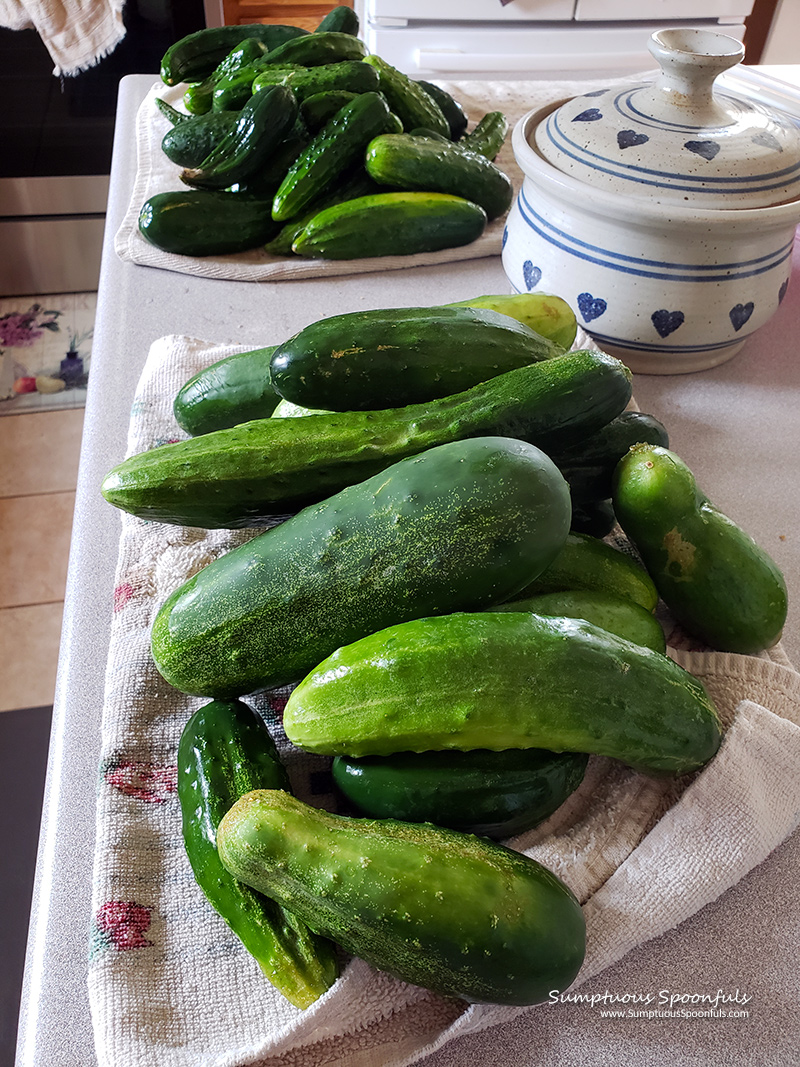
Every chance I get to spend with my parents taking care of food is absolutely precious to me … I don’t know how many more moments there will be, and I just want to savor every little bit. Digging potatoes, making pickles, bottling wine. Both of my parents are aging, yet they keep doing all the same things … and I just want to share every bit of time I can with them. It’s exciting to share the progress of our projects too as the fermentation develops!
Is Fermentation Difficult?
I was a little intimidated about the whole fermentation thing until my dad (via my sister) introduced me to fermented salsa a while ago. When I tasted fermented salsa for the first time, it was love at first bite. I was SO amazed to learn how easy it is!
I have since delved into other fermentation experiments like sourdough, one of the oldest forms of fermenting grain (I’ve made bread, crackers, runzas, French rolls, Brioche buns, crescent rolls … and so much more), plus water kefir, a delightfully fizzy fruity drink (that I haven’t blogged about yet, but it’s surprisingly easy and so delightful!) … and my latest fermentation obsession: fermented pickles. These are truly the easiest pickles you’ll ever make. To make fermented pickles, you simply make sure all the good things are covered with a salty brine, then let the pickles sit out at room temperature for 2 – 4 days.
Is Fermentation Safe?
When making pickles or canning foods, people tend to worry about botulism … and that’s a legit worry because botulism is deadly, but fermentation (done properly) is a process that literally cannot lead to botulism. Fermentation is the original method of pickling and IMHO, the best way to make a good pickle to this day. Read the full article here to learn more, but here’s my key take-away:
Fermenting foods creates an environment that is antagonistic to botulism. It’s what scientists call “competitive exclusion.” Beneficial bacteria begin to acidify the food, a condition C. botulinum doesn’t like. Adding salt to a ferment also reduces C. botulinum’s ability to grow, and encourages beneficial bacteria to take over. There are also other “competitive factors” that beneficial bacteria and fungi create in smaller quantities to exclude pathogenic varieties.
Aside from the health benefits, the other great thing about fermenting foods is they last SOOOOO much longer! A fresh salsa keeps maybe a week in the fridge, but a fermented salsa will keep for months. These fermented pickles will also last for quite a long time in the fridge, but seriously, they won’t last that long because you’ll want to be munching on these crunchy immune-boosting pickles every day.
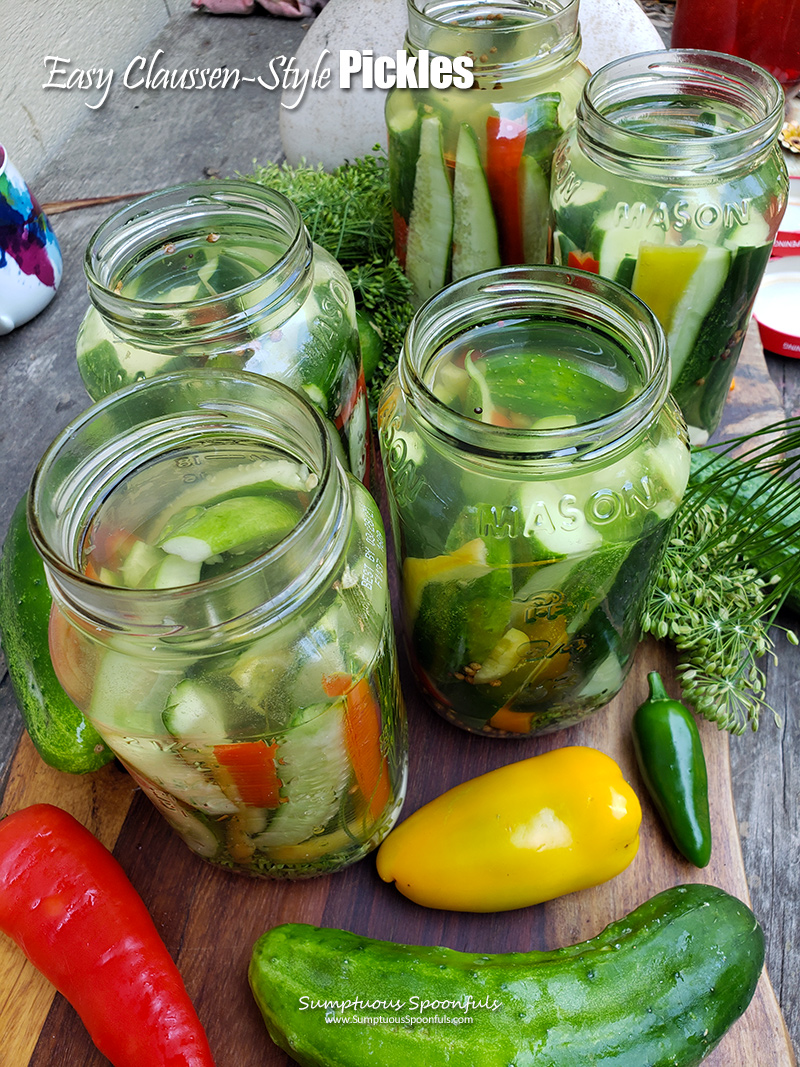
Tips for crunchy, healthy and safe fermented pickles
Take note of these key points for making SAFE and delicious fermented pickles:
- Use the right salt. Use canning and pickling salt, NOT iodized salt for fermentation … the iodine will kill the good bacteria you are trying to grow.
- Make sure you have at least 2.5% salt to water ratio. This recipe is well above that, but you can reduce the salt if needed, as long as the salt/water ratio is above 2.5%.
- Include a leaf that includes tannins to encourage the crunch factor. This recipe uses bay leaves, but my dad uses grape leaves. Other people use oak leaves, blackberry, cherry, raspberry, horseradish or even black or green tea leaves.
- Vinegar is not needed to make fermented pickles. It is included in this recipe I think mostly for that vinegar pickle taste we are so used to, but my parents make their fermented pickles without any vinegar.
- Since these pickles are not water bath or pressure canned, you can use unconventional jars and save your canning jars (and lids!) for the things you want to can.
- The brine MUST completely cover everything. This is super important. If you notice your pickles wanting to float up to touch the top, then you’ll want to weight them down. You can use small flat stones from your yard, but make sure the stones are well cleaned and sterilized.A grape leaf on top with a weight is a good way to ensure nothing floats to the top. One exception: if you see a couple of the dried seeds floating to the top, not to worry.
Notice in this picture how there’s a nice amount of space for the brine on top:
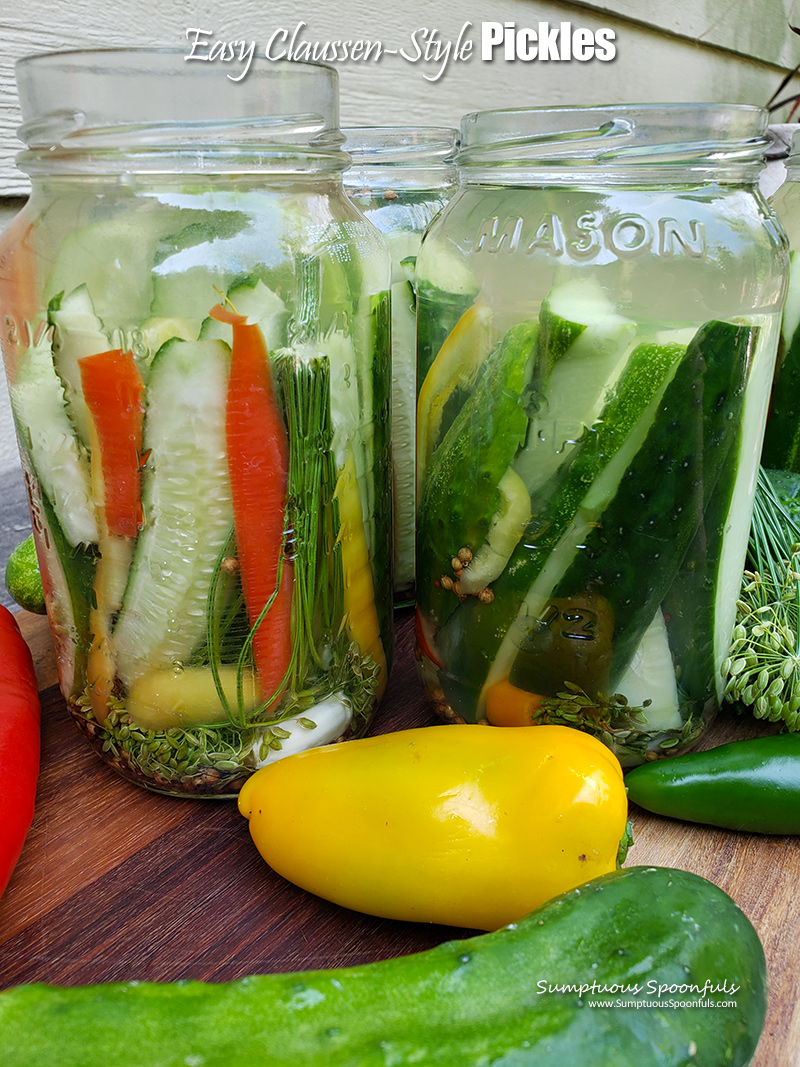
What Kind of Cucumbers Should I Use for these Pickles?
Some people will insist that you must use only the “pickling” cucumbers, but I have tried with multiple kinds so I say: use any cucumbers you have … and if you don’t have cucumbers, use whatever you DO have. As I mentioned earlier, I made a jar of these pickles with zucchini, carrots and peppers and they turned out SUPER crunchy and good! Don’t be afraid to switch it up.
How to Gather Dill (Easy and Tangle Free!)
My parents teach me the most useful things. Mom helped me know which dill heads are the best to use for pickling. Don’t grab the ones that are still flowering. Pick the ones that have the dill seeds on the ends. Thanks mom!
And this weekend, my dad shared this super helpful trick for gathering dill for your pickles. This is especially helpful if you need to gather a LOT of dill from the garden … depending on the size of your hand, you can hold between 20 and 40 heads of dill in one hand.
Simply cut the top off the dill about 1/2 inch below the spreading point (the place where all the little stems go out from the center stem). Then fold it all up like an umbrella and put it in the palm of your hand. Repeat, using your dominant hand for cutting and folding up the dill “umbrellas” and adding them to the other hand that is holding the dill heads. I have very small hands and I was able to fit 21 heads of dill in one hand (WAY more than we needed for all the pickles we made!)
Even if you’re only gathering a few heads of dill, this method makes it really simple to hold them all in one hand without getting them all tangled up.
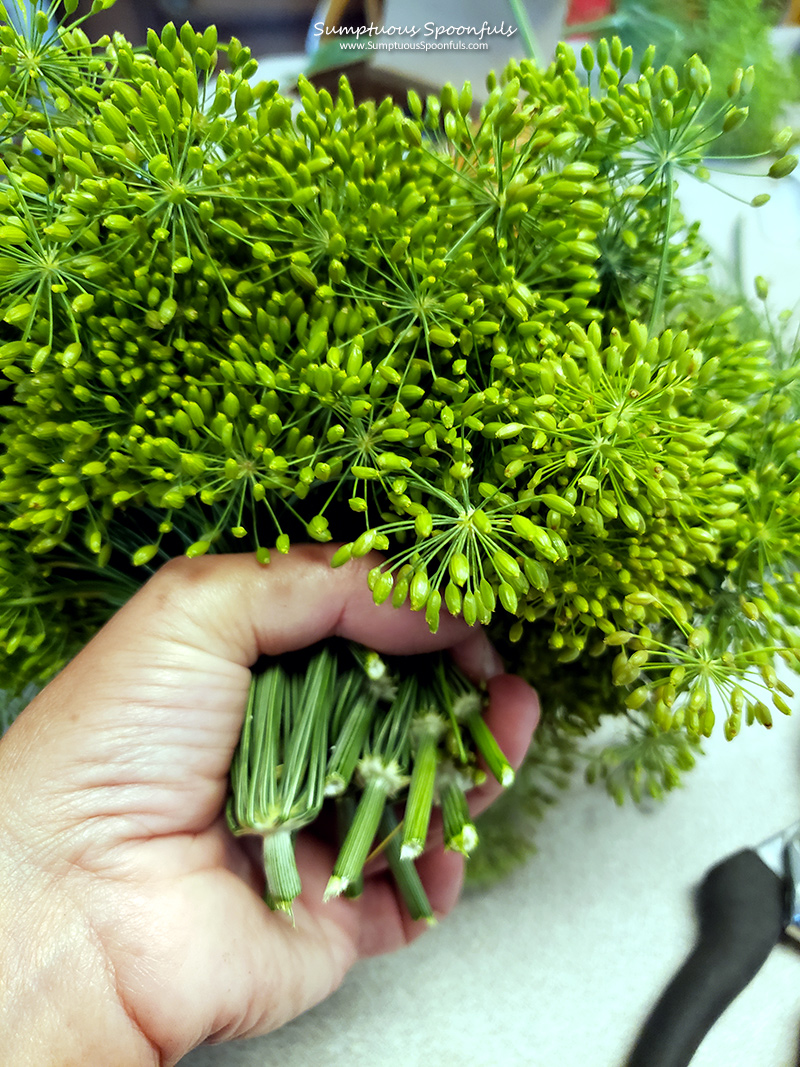
If you need to transport your dill heads, you can then use a rubber band to hold your “dill bouquet” intact and put it in a bag until you’re ready to use it. You can pull off dill heads quite easily with little to no tangling! How clever is that?
Recipe adapted from Foodie with Family
Print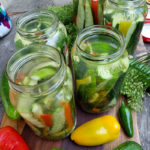
Easy Claussen Style Pickles
Description
Wonderfully CRUNCHY and super tasty pickles that are fermented so they have probiotics that provide so many health benefits. So easy to make as well! Follow the tips in the post for total fermentation success.
Ingredients
For the brine:
- 1/4 cup apple cider vinegar (preferably raw)
- 1/6 cup (about 1/2 of a 1/3 cup measure) of canning/pickling salt
- About 1 quart water
For a 25-oz. jar of pickles (double the amounts for quart or larger jars, use a little less for pint jars):
- 2 crushed bay leaves
- 1 teaspoon mustard seed
- 1 teaspoon coriander seed
- A pinch of red pepper flakes
- 1 dill head
- 2 – 5 cloves garlic, peeled
- Fresh cut cucumbers plus sweet and/or hot pepper strips (peppers are optional, but they add color and flavor! )
Instructions
- Clean the cucumbers and soak in an ice water bath for at least 15 minutes. This helps crisp them up. Trim the bottom and top of each cucumber, then slice in half lengthwise or cut into smaller spears. Cut the peppers into slices.
- Add the vinegar and salt to a quart jar and fill about half way with water. Stir until the salt is fully dissolved, then fill the jar with water.
- In each pickle jar, add the bay leaves, garlic and seasonings on the bottom, then put in the dill head. Pack the cucumbers and peppers in until the jar is mostly full, leaving at least 3/4 inch of space on top.
- Pour the brine in to fill the jar and completely cover all the vegetables with at least 3/4 – 1 inch of liquid. If you have any veggies that want to float to the top, put a weight on top like a small (disinfected) stone.
- Cover loosely and let sit for 2 – 4 days, then cover tightly, refrigerate and enjoy!
Notes
Also, try adding in other veggies like zucchini, carrot sticks, or sliced fennel. Fresh fennel fronds (the greens on the top) add a nice flavor too.
© Copyright 2021, Sumptuous Spoonfuls. All images & content are copyright protected. I love it when you share, but please do not use my images on your own site/page without prior permission. If you want to publish any of my images, please ask first. Sharing, pinning, and tweeting is always appreciated as long as the shares and pins link back to here for the recipe. If you want to republish this recipe as your own, please re-write the recipe in your own words or link back to this post for the recipe.
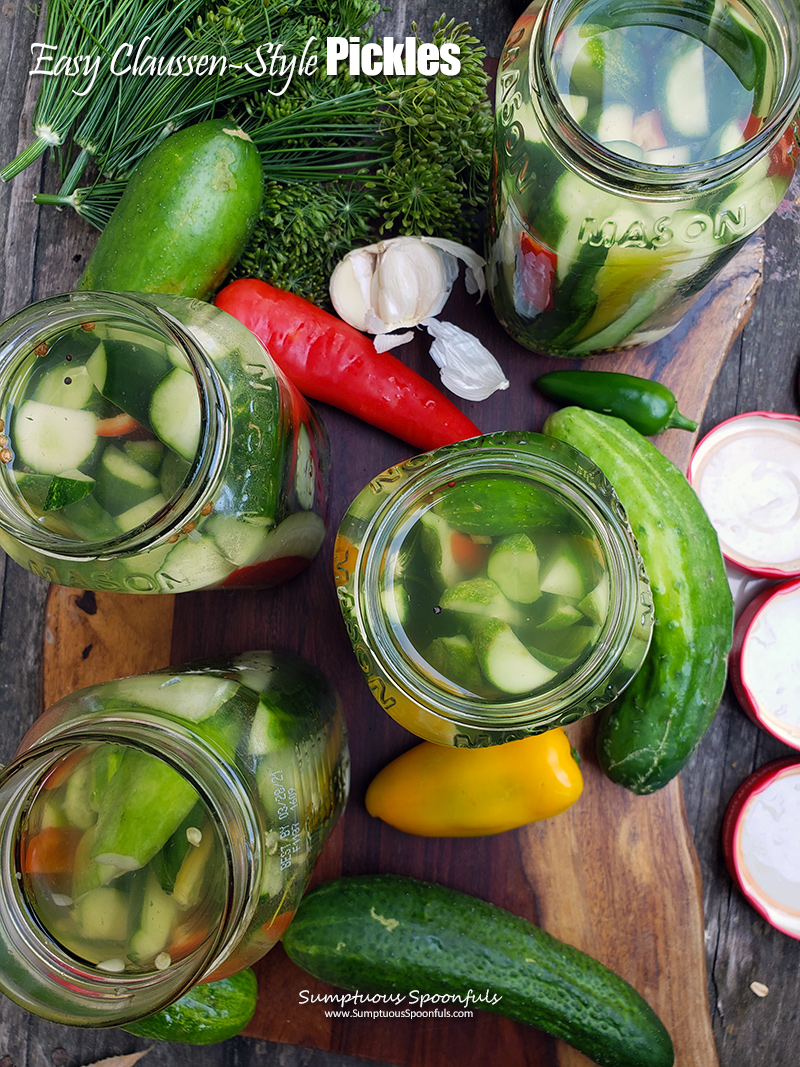

14 comments
Love love love pickling and fermenting is something I’ve not done very often at all, but you just made it look and sound so easy. Now I need to try this.
★★★★★
It really IS super easy, Mary! So much easier than canning pickles. I think you’ll be hooked once you try it. 🙂
– Ann
I can’t wait to try this method! My family always bonded around food and my mother was a canner. I quit that years ago and love that I can make smaller less hectic batches of fermented pickles.
I agree, Julie … these fermented pickles are so nice because you can make a little batch whenever you have a few cucumbers (or other veggies) that you want to pickle! Save any excess brine in a jar for next time.
These pickles look so good! I love a good refrigerator pickle, and love the idea of using this fermented recipe!
[…] Easy Claussen Style (Fermented) Pickles (super crunchy, full of probiotics, keeps for months in the fridge) […]
Vinegar kills probiotics, hence only pickles that are fermented without vinegar have probiotics. That’s why your parents made them with just saltwater and no vinegar.
Hi Scott,
I’ve heard the same, but I have also seen debate about that as vinegar is also a fermented food containing probiotics. So yeah, I think the jury’s still out on that one. In any case, my pickles did seem to ferment — they got nice and bubbly just like a good fermented pickle should. I always feel the “boost” that probiotics provide when I eat one. And they are still good and crunchy 6 months later! I did find one post that stated that vinegar increases the acidity which some bacteria cannot survive, but others still continue on … and that definitely seems plausible. FYI, I did use the raw apple cider vinegar, not the processed vinegar.
With all that said, I would say you can definitely skip the vinegar if you so desire.
Thanks for your comment!
Ann
[…] Chopped pickles (we like to use our Claussen-style pickles) […]
[…] some of my homemade fermented pickles this year turned out tasty, but not quite great, I thought of Becky. And her crazy good dill pickle […]
[…] pretty dang cool. Plus if you’re using fermented pickles (I’m lookin’ at you, Claussen style pickles), this dip even delivers probiotics for your digestive and immune system. If you eat this dip with […]
Can you pickle eggs this way? I’m excited to get some green tomatoes and ferment them this way. Thank you for the recipe!
Hi Bear,
I haven’t tried pickling eggs, but Fermenting for Foodies says you can.
I like the idea of pickling green tomatoes. I bet that would be really good. I’ve personally only done cucumbers, onions and eggplant. Although theoretically, this method would work with any veggie.
Let me know how it turns out with the green tomatoes!
Ann
[…] Greek yogurt supplies calcium, protein and a good part of the probiotics in this dip. The pickles provide the rest of the probiotics, especially if you use fermented pickles. […]